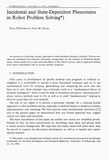Article
Full entry |
 PDF
(0.9 MB)
Feedback
PDF
(0.9 MB)
Feedback
 PDF
(0.9 MB)
Feedback
PDF
(0.9 MB)
Feedback
References:
[1] R. E. Fikes N. J. Nilsson: STRIPS: A new approach to the application of theorem proving to problem solving. Artificial Intelligence 2 (1971), 189-208.
[2] C. Green: Application of theorem proving to problem solving. Proc. IJCAI'69, Washington, D.C., 1969.
[3] I. M. Havel: Finite branching automata. Kybernetika 10 (1974), 281 - 302. MR 0381383 | Zbl 0287.94050
[4] I. M. Havel: Nondeterministic finite branching automata. Res. Report No 623, ÚTIA-ČSAV 1975. MR 0381383
[5] I. M. Havel, I, Kramosil: A stochastic approach to robot plan formation. Submitted for publication. Zbl 0388.68084
[6] R. Kowalski: Logic for problem solving. Memo No. 75, Department of Computational Logic, University of Edinburgh 1974.
[7] N. J. Nilsson: Problem-Solving Methods in Artificial Intelligence. McGraw-Hill, New York 1971.
[8] H. A. Simon: On reasoning about actions. In Representation and Meaning: Experiments with Information Processing Systems (eds. H. A. Simon & L. Siklossy), Prentice-Hall, Englewood Cliffs 1972, pp. 414-430.
[9] M. Sintzoff: Eliminating blind alleys from backtrack programs. In: Automata, Languages, and Programming (S. Michaelson and R. Milner, Eds.), Edinburgh University Press 1976, pp. 531-557. Zbl 0362.68053
[10] O. Štěpánková: Skolem functions and the planning in the situation calculus. A collection of papers 1975 Inst, of Computation Techniques, Technical University of Prague 1975.
[11] O. Štěpánková I. M. Havel: A logical theory of robot problem solving. Artificial Intelligence 7(1976), 129-161. MR 0413627
[12] R. Waldinger: Achieving several goals simultaneously. In: Machine Intelligence 8 (E. W. Elcock and D. Michie, Eds.), Ellis Horwood, Chichester 1977, pp. 94-136.
[13] D. H. D. Warren: Generating conditional plans and programs. In: AISB Conf. Proceedings, University of Edinburgh 1976, pp. 344-354.

